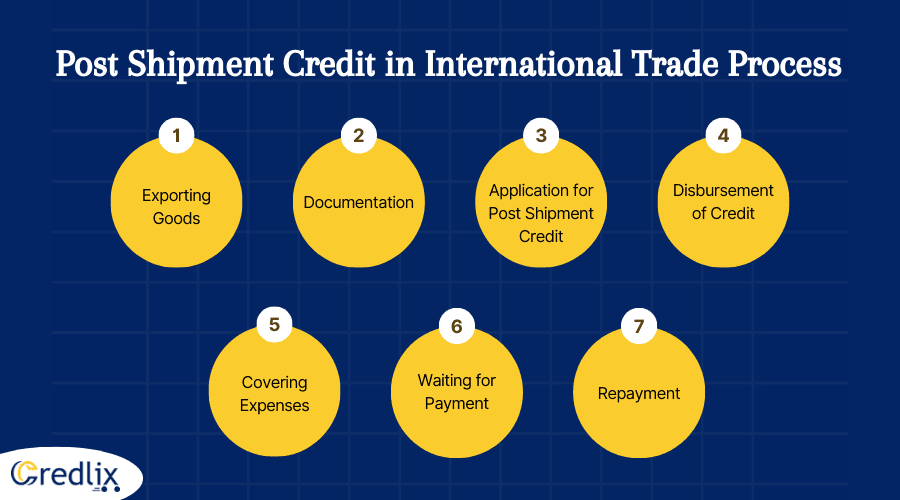
Post shipment credit plays a crucial role in smoothing the wheels of international trade. It serves as a financial lifeline for exporters, enabling them to fulfill orders and meet operational expenses after goods have been shipped. This credit facility bridges the gap between shipment and payment receipt, alleviating cash flow constraints that often accompany lengthy shipping and payment cycles. By providing exporters with timely access to funds, post shipment credit encourages trade expansion, fosters economic growth, and enhances competitiveness in global markets.
Importers also benefit from this arrangement, as it facilitates smoother transactions and fosters trust between trading partners. In essence, post shipment credit serves as a vital lubricant in the machinery of international trade, facilitating smooth operations and driving commerce forward.
What is Post Shipment Credit
Post shipment credit is a financial arrangement offered by banks and financial institutions to exporters following the shipment of goods. It allows exporters to obtain short-term financing to cover expenses incurred in the export process until payment is received from the importer. This credit facility assists exporters in managing cash flow effectively by providing funds for production costs, transportation, and other operational expenses related to exporting.
Post shipment credit is typically provided in the form of advances against export documents or bills of exchange, allowing exporters to access liquidity while awaiting payment for their exported goods. It plays a crucial role in facilitating international trade by enabling exporters to fulfill orders and sustain their business operations without being hampered by cash flow constraints during the shipment and payment cycle.
Understanding Post Shipment Credit In International Trade With an Example
Post shipment credit is a financial service crucial in international trade, assisting exporters in managing cash flow between shipping goods and receiving payment. Here’s an example to illustrate its function:
Let’s imagine you own a clothing manufacturing company in Country A, and you’ve just shipped a large order of garments to a distributor in Country B. The shipment’s total value is $50,000, but your distributor won’t pay until they receive the goods and sell them to retailers.
Meanwhile, you have expenses to cover: purchasing raw materials, paying your workers, and managing operational costs. This is where post shipment credit comes in. You approach your bank in Country A and present the shipping documents as proof of the transaction. The bank agrees to extend you a credit line of $50,000 for a period, say, 60 days.
With this credit, you can settle your immediate expenses while waiting for the distributor’s payment. Once the distributor receives the goods and sells them, they pay you the $50,000. You then use that money to repay the bank.
In this scenario, post shipment credit enables you to fulfill orders, maintain production, and sustain your business operations smoothly, despite the delay in receiving payment from your overseas buyer.
Post Shipment Credit in International Trade Process

Post shipment credit is an integral part of the international trade process, providing crucial financial support to exporters. Here’s how it fits into the overall process:
Exporting Goods: The process begins when an exporter ships goods to a buyer in another country. This could be anything from manufactured goods to raw materials or agricultural products.
Documentation: After the shipment, the exporter prepares all necessary export documents, including the bill of lading, invoice, packing list, and any other required paperwork.
Application for Post Shipment Credit: With the export documentation in hand, the exporter applies for post shipment credit from a bank or financial institution. The bank evaluates the documents and the creditworthiness of the exporter before approving the credit.
Disbursement of Credit: Once approved, the bank disburses the post shipment credit to the exporter. This credit could be in the form of a loan or an advance against the value of the exported goods.
Covering Expenses: The exporter uses the post shipment credit to cover various expenses incurred during the export process, such as production costs, transportation fees, packaging, and other operational expenses.
Waiting for Payment: Despite shipping the goods, the exporter typically has to wait for the buyer to receive the goods and make the payment. This waiting period can range from days to weeks or even months, depending on the terms of the sale.
Repayment: When the buyer pays for the goods, the exporter receives the payment and uses it to repay the post shipment credit to the bank. This completes the financial transaction.
Overall, post shipment credit provides exporters with much-needed liquidity to sustain their business operations while waiting for payment from overseas buyers, thereby facilitating smoother international trade transactions.
Benefits of Post Shipment Credit in International Trade
Post shipment credit in international trade refers to the credit facility extended to exporters after the shipment of goods, enabling them to meet various financial requirements arising from the export transaction. Here are 15 benefits of post shipment credit:
Working Capital Flexibility: Post shipment credit provides exporters with flexibility in managing their working capital by allowing them to receive payment for goods shipped before settling their financial obligations.
Cash Flow Management: Exporters can better manage their cash flow since they can receive payment for their exports while still having time to fulfill their financial commitments.
Risk Mitigation: It helps mitigate risks associated with delayed payments or non-payment by buyers in foreign markets, as exporters receive funds even before the buyer pays.
Competitive Advantage: Access to post shipment credit can give exporters a competitive edge by allowing them to offer favorable credit terms to buyers, thus attracting more customers and increasing sales.
Market Penetration: Exporters can penetrate new markets more effectively by offering attractive credit terms, thereby expanding their customer base and market share.
Reduced Financing Costs: Post shipment credit often comes at lower financing costs compared to other forms of short-term financing, such as loans or overdraft facilities, which can lead to cost savings for exporters.
Improved Liquidity: Exporters can improve their liquidity position by accessing funds through post shipment credit, which can be used to fund ongoing business operations or investment activities.
Avoidance of Payment Delays: Exporters can avoid delays in receiving payment from buyers by utilizing post shipment credit, ensuring a steady flow of funds to support their business activities.
Facilitates Larger Orders: With access to post shipment credit, exporters can fulfill larger orders from buyers without being constrained by immediate cash requirements, thereby maximizing their export potential.
Enhanced Customer Relations: Offering post shipment credit to buyers can enhance customer relations and foster long-term business partnerships by demonstrating trust and flexibility in payment terms.
Better Negotiation Power: Exporters with access to post shipment credit may negotiate more favorable terms with suppliers and other stakeholders, leveraging their improved financial position.
Streamlined Export Process: Post shipment credit simplifies the export process by providing exporters with timely access to funds, reducing administrative burden and paperwork associated with managing cash flow.
Facilitates Export Financing: It serves as an essential tool for exporters to finance various export-related activities, including production, packaging, transportation, and marketing expenses.
Compliance with Trade Regulations: Utilizing post shipment credit can help exporters comply with trade regulations and contractual obligations, ensuring smooth and efficient export transactions.
Supports Economic Growth: Access to post shipment credit promotes economic growth by facilitating international trade and fostering business expansion, leading to increased employment opportunities and overall prosperity.
Final Note
Post shipment credit is like a safety net for exporters, allowing them to navigate the complexities of international trade with confidence. By providing access to funds after goods have been shipped, it smoothes cash flow, reduces financial risks, and opens doors to new opportunities. This credit facility not only supports exporters in fulfilling orders and expanding their businesses but also strengthens relationships with buyers and enhances competitiveness in global markets. With post shipment credit, exporters can focus on what they do best – delivering quality products to customers around the world – while financial worries take a back seat. It’s a vital cog in the machinery of international trade, ensuring that commerce flows smoothly and economies thrive.


















